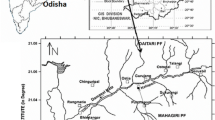Abstract
Coal is a major natural resource of Northeast India and the indigenous process of coal mining known as rat-hole mining results in the pumped mine water being released to the nearby land and water bodies contaminating the area and destroying life forms due to acid mine drainage. The present study aimed at isolating acid and metal resistant bacteria from the rat-hole coal mines to assess their acid and metal tolerance isolated two Bacillus sp. with good tolerance to iron, cadmium and chromium which grew well at pH 5 and could remain viable up to pH 2 without any apparent growth. Growth experiments at pH 2–4 indicated the failure of the isolates to grow and produce colony though they survived metabolically viable. However the inoculum obtained from broth culture incubated for 72 h at pH 2–4 produced distinct colonies when plated in medium at pH 5. Bacillus subtilis subsp. inaquosorum SK22 showed comparatively higher maximum tolerable concentration (MTC) for iron in comparison to Bacillus cereus SK44. Both had the same MTC for both cadmium and chromium. The minimum inhibitory concentration (MIC) and maximum bactericidal concentration (MBC) was similar for cadmium and chromium for both the Bacillus sp. MIC and MBC for iron was higher in case of Bacillus subtilis subsp. inaquosorum SK22 than that of Bacillus cereus SK44. This higher resistance to acidic pH and high metal concentration indicated their potential to be good candidates for bioremediation of contaminated soil and water bodies affected by rat-hole mining and acid mine drainage.






Similar content being viewed by others
References
Swer S, Singh OP (2004) Status of water quality in coal mining areas of Meghalaya, India. In: Proceedings of the national seminar on environmental engineering, with special emphasis on mining environment (India). pp 1–9
Dasgupta S, Tiwari BK, Tripathi RS (2002) Coal mining in Jaintia hills, Meghalaya: an ecological perspective. In: Jaintia hills, a Meghalaya tribe: its environment, land and people. Reliance Publishing House, India, pp 121–128
Johnson DB, Hallberg KB (2005) Acid mine drainage remediation options: a review. Sci Total Environ 338:3–14
Stumm W, Morgan JJ (1981) Aquatic chemistry: an introduction emphasizing chemical equilibria in natural waters. Wiley, New York, p 780
Johnson DB, Hallberg KB (2003) The microbiology of acidic mine waters. Res Microbiol 154:466–473
Rayment GE, Higginson FR (1992) Australian laboratory handbook of soil and water chemical methods, Australian soil and land survey handbook, vol 3. Inkata Press, Melbourne, pp 1–3
Gupta K, Chatterjee C, Gupta B (2012) Isolation and characterization of heavy metal tolerant Gram-positive bacteria with bioremedial properties from municipal waste rich soil of Kestopur canal (Kolkata), West Bengal, India. Biologia 65:827–836
Yilmaz EI (2003) Metal tolerance and biosorption capacity of Bacillus circulans strain EB1. Res Microbiol 154:409–415
Kumar R, Acharya C, Joshi SR (2011) Isolation and analyses of uranium tolerant Serratia marcescens strains and their utilization for aerobic uranium U(VI) biosorption. J Microbiol 49:568–574
Samanta A, Bera P, Khatun M, Sinha C, Pal P, Lalee A, Mandal A (2012) An investigation on heavy metal tolerance and antibiotic resistance properties of bacterial strain Bacillus sp. isolated from municipal waste. J Microbiol Biotech Res 2:178–189
Prescott LM, Harley JP (2002) Laboratory exercise in microbiology, 5th edn. Mc Graw-Hill Companies Inc., New York
Buchanan RM, Gibbons NE (1974) Bergey’s manual of determinative bacteriology, 8th edn. The Williams and Wilkins Company, Baltimore
Gunaseelan C, Ruban P (2011) Heavy metal resistance bacterium isolated from Krishna Godavari basin, Bay of Bengal. Int J Environ Sci 1:1856–1864
Pandit RJ, Patel B, Kunjadia PD, Nagee A (2013) Isolation, characterization and molecular identification of heavy metal resistant bacteria from industrial effluents, Amala-khadi-Ankleshwar, Gujarat. Int J Env Sci 3:1689–1699
Chun J, Lee JH, Jung Y, Kim M, Kim S, Kim BK, Lim YW (2007) EzTaxon: a web-based tool for the identification of prokaryotes based on 16S ribosomal RNA gene sequences. Int J Syst Evol Microbiol 57:2259–2261
Tamura K, Dudley J, Nei M, Kumar S (2007) MEGA4: molecular evolutionary genetics analysis (MEGA) software version 4.0. Mol Biol Evol 24:1596–1599
Rudakiya DM, Pawar KS (2013) Evaluation of remediation in heavy metal tolerance and removal by Comamonas acidovorans MTCC 3364. IOSR JESTFT 5:26–32
Khare S, Ahmed N, Pant S, Das R (2010) Characterization and evaluation of heavy metal tolerance of bacterial species from soil of waste area near Riyan steel rolling mills, Muzaffarnagar, India. J Appl Nat Sci 2:88–92
Rajbanshi A (2008) Study on Heavy metal resistant bacteria in Guheswori sewage treatment plant. Our Nat 6:52–57
Govarthanan M, Shim J, Kim SA, Kamala-Kannan S, Oh B (2015) Isolation and characterization of multi-metal-resistant Halomonas sp. MG from Tamil Nadu magnesite ore soil in India. Curr Microbiol. doi:10.1007/s00284-015-0897-4
Goulhen F, Gloter A, Guyot F, Bruschi M (2006) Cr(VI) detoxification by Desulfovibrio vulgaris strain Hildenborough: microbe–metal interactions studies. Appl Microbiol Biotech 71:892–897
Konishi S, Souta I, Takahashi J, Ohmoto M, Kaneko S (1994) Isolation and characteristics of acid- and Aluminum-tolerant bacterium. Biosci Biotech Biochem 58:196–1963
Acknowledgements
The authors acknowledge the financial support received from the Department of Biotechnology, Govt. of India (Sanction No. DBT/484/NE/TBP/2013 dated/9/4/2014).
Author information
Authors and Affiliations
Corresponding author
Ethics declarations
Conflict of interest
There is no conflict of interest for publication of this manuscript among the authors.
Rights and permissions
About this article
Cite this article
Ka-ot, A.L., Banerjee, S., Haldar, G. et al. Acid and Heavy Metal Tolerant Bacillus sp. from Rat-Hole Coal Mines of Meghalaya, India. Proc. Natl. Acad. Sci., India, Sect. B Biol. Sci. 88, 1187–1198 (2018). https://doi.org/10.1007/s40011-017-0856-x
Received:
Revised:
Accepted:
Published:
Issue Date:
DOI: https://doi.org/10.1007/s40011-017-0856-x




